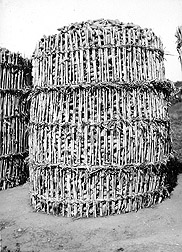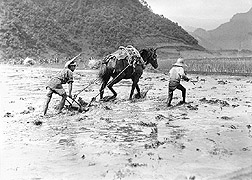Treasures of the National Agricultural Library: USDA Plant Collectors' Exotic Expedition Captured in Historical Photo Albums |
|
 P.H. Dorsett tries a waterwheel. (K10486-2) |
It was the adventure of a lifetime. From 1929 through 1931, pioneering plant explorer Palemon Howard Dorsett and colleague William Joseph Morse were assigned to travel throughout the rural countryside of Japan, Korea, and Manchurian China. Their quest: Find and send home examples of rare, wild, and cultivated soybeans—a crop that had captured the interest of American farmers. Expedition leader Dorsett was a senior plant explorer with USDA's Office of Seed and Plant Introduction in Washington, D.C. Colleague Morse, a soybean expert and junior member of the team, was also based in Washington, working with the USDA Office of Forage Crops. The living bounty of the expedition helped to build this country's soybean industry. Today, plants that are descendants from original specimens collected by Dorsett and Morse in the Far East are still carefully maintained at ARS genebanks. |
 After harvest, corn is kept in bins or cribs made of kaoliang stocks. (K10486-3) |
But these voyagers brought back another treasure, this one in the form of hundreds of black-and-white photographs. These images capture the excitement of the expedition and give an inside look at Asia between the two world wars. The Seven Albums of Asia The people, farmlands, and farming practices of Asia come to life in this varied collection. More than 1,000 prints documenting the expedition are preserved in paperboard or clothbound photograph albums at the ARS National Agricultural Library in Beltsville, Maryland. Each print is pasted on heavy green paper, typical of that used for photograph albums of the early 1900s. Researchers visiting the library can, by appointment, view the albums. Armchair travelers can conveniently read about the expedition and browse a selection of nearly 50 prints simply by logging onto the library's unique web site for the Dorsett-Morse expedition. It's located on the World Wide Web at www.nal.usda.gov/speccoll/findaids/dorsett. |
 Early plant explorers led by P.H. Dorsett from 1921 through 1931 thought this view of the Great Wall of China represented the general character and appearance of the Asian countryside at that time. (K10486-1) |
Photographs featured on the web site are grouped into seven categories—as are the albums. Among them: "Farm Views," "Landscapes," "Ornamentals," and "Temples and Shrines." The web site includes a helpful history of the expedition and a short biography of Dorsett. Every web photograph is accompanied by a caption. These notations duplicate the handwritten originals, penned in black ink. "We don't know who wrote the captions for the photograph albums," notes Susan H. Fugate, head of the library's Special Collections, "but whoever did generally included the date, location where the photograph was taken, and the name of the plant or object shown." |
 Farming practices, especially rice cultivation as shown here, were the subject of many plant explorer photos. (K10486-4) |
"This like all the other pictures made [today]," one caption notes, "was made from under a Japanese Kasa or umbrella in the rain." Another explains, "Soja ussuriensis. Wild soy bean. View [of] the wild soy bean plants growing along road side on [the] outskirts of Heijo.... These plants appear different from wild soy bean found in Manchuria and Japan. The leaves are larger and somewhat different[ly] shape[d]." An Astragalus plant that was thought to have good potential as forage for livestock in the United States was identified "...in the grounds of the Temple of Heaven. A nice lot of seed of this species was secured and sent... It looks promising." "...Ming Tomb, China" begins a caption from the "Ornamentals" volume. "These plants were collected outside of the tomb...The flowers very much resemble violets both in shape and color. This plant should be good for rockeries in shady moist situations." |
 P.H. Dorsett (second from right) and his Chinese interpreter Peter Liu on the trail. (K10486-5) |
Soybeans Take Root Today, soybeans are the second largest U.S. crop, worth more than $14 billion in 2002. Food uses that farmers envisioned are part of that market. What's more, studies are revealing the new benefits of soy compounds such as isoflavones. Soy is also a key ingredient in livestock feed and is an important source of natural chemical compounds for consumer and industrial products. These include paints, plastics, stain removers, and cleansers. Some of the credit for this current success can be attributed to the Dorsett-Morse expedition. The team brought back about 4,500 soybean specimens as well as another 4,500 specimens of interest. Some of the soybean plants had prized traits, such as resistance to harmful microbes that could otherwise devastate the crop. Dorsett, born in Illinois in 1862 and educated at the University of Missouri, joined USDA in 1891. After more than a decade, he left the department to start his own business, then rejoined as a plant explorer in Washington, D.C., in 1909. The Dorsett-Morse Oriental Exploration Expedition was an unqualified success and further enhanced Dorsett's reputation as a premier plant explorer. In 1936, he won the Frank N. Meyer Medal from the Council of the American Genetic Association for his outstanding work. The award was named in honor of another USDA plant explorer, who died under what some claim were mysterious circumstances while on a collecting expedition in China. But that's another story.—By Marcia Wood, Agricultural Research Service Information Staff. Susan H. Fugate is with USDA-ARS National Agricultural Library, Special Collections, Abraham Lincoln Building, 10301 Baltimore Ave., Beltsville, MD 20705; phone (301) 504-6503, fax (301) 504-7593. "Treasures of the National Agricultural Library: USDA Plant Collectors' Exotic Expedition Captured in Historical Photo Albums" was published in the June 2003 issue of Agricultural Research magazine.
|






